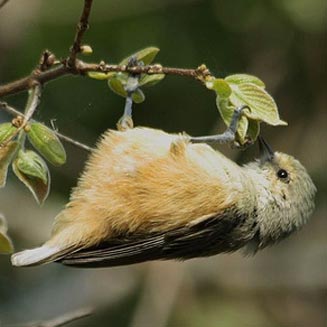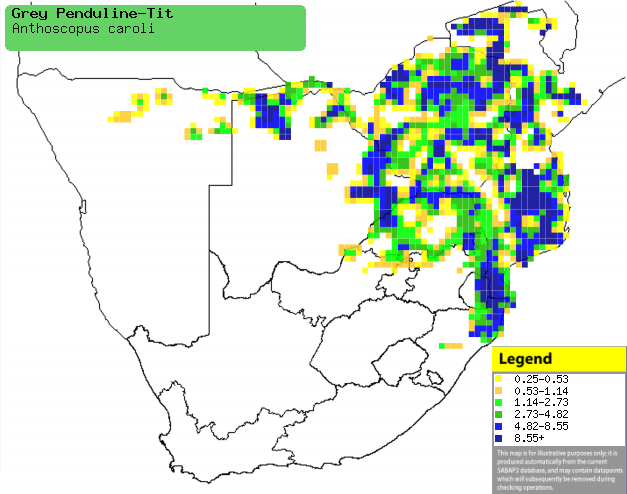|
Anthoscopus caroli (Grey
penduline-tit)
Kaapse kapokvoël [Afrikaans]; Unogushana, Unothoyi
[Xhosa]; Acacia-kapokmees [Dutch]; Rémiz minute [French]; Kapbeutelmeise
[German]; Pássaro-do-algodão-cinzento [Portuguese]
Life
> Eukaryotes >
Opisthokonta
> Metazoa (animals) >
Bilateria >
Deuterostomia > Chordata >
Craniata > Vertebrata (vertebrates) > Gnathostomata (jawed
vertebrates) > Teleostomi (teleost fish) > Osteichthyes (bony fish) > Class:
Sarcopterygii (lobe-finned
fish) > Stegocephalia (terrestrial
vertebrates) > Tetrapoda
(four-legged vertebrates) > Reptiliomorpha > Amniota >
Reptilia (reptiles) >
Romeriida > Diapsida > Archosauromorpha > Archosauria >
Dinosauria
(dinosaurs) > Saurischia > Theropoda (bipedal predatory dinosaurs) >
Coelurosauria > Maniraptora > Aves
(birds) >
Order: Passeriformes > Family: Paridae
 |
|
|
Grey penduline-tit, Mkhuze Game Reserve,
KwaZulu-Natal, South Africa. [photo
Alan Manson
©] |
|
For information about this species, see
www.birdforum.net/opus/African_Penduline_Tit
Distribution and habitat
Occurs from Uganda through southern DRC to Angola, south to
southern Africa. Here it is common in patches across Botswana, Namibia, eastern
Zimbabwe and much of South Africa, excluding KwaZulu-Natal bordering on the
Eastern Cape and parts of Mpumalanga and the Limpopo Province. It prefers
broad-leaved woodland dominated by bushwillows (Combretum), silver
cluster-leaf (Terminalia sericea), Burkea (Burkea Africana) and
miombo (Brachystegia). It is also occasionally found in Acacia
woodland and suburban gardens.
|
 |
|
Distribution of Grey penduline-tit in southern Africa,
based on statistical smoothing of the records from first SA Bird Atlas
Project (©
Animal Demography unit, University of
Cape Town; smoothing by Birgit Erni and Francesca Little). Colours range
from dark blue (most common) through to yellow (least common).
See here for the latest distribution
from the SABAP2. |
Food
It mainly eats insects, often foraging in the tree canopy,
gleaning prey from twigs and branches. It may also join mixed-species foraging
flocks, often alongside eremomelas,
Southern hyliota,
Willow warbler and
white-eyes.
Breeding
- Both sexes construct the nest, which is an oval-shaped bag built of woven
spider web, plant down and other woolly material. A collapsible entrance
spout is placed near the top, which can be opened and closed by drawing the
top and bottom sides of the tube together. Underneath the entrance there is
a small ridge which serves as a perch for the bird to open the entrance
spout with one foot. The top and bottom of the nest are usually attached to
twigs of a tree, approximately 5-10 metres above ground.
- Egg-laying season is from August-February, peaking around
September-November.
- It lays 2-8, usually 4 eggs which are incubated for an estimated 15-19
days.
- Both adults feed the young, who leave the nest when they are about 22-26
days old.
Threats
Not threatened.
References
-
Hockey PAR, Dean WRJ and Ryan PG 2005. Roberts - Birds of
southern Africa, VIIth ed. The Trustees of the John Voelcker Bird Book
Fund, Cape Town.
|
